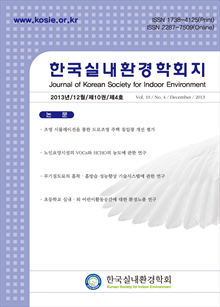간행물
한국실내환경학회지 KCI 등재후보 Journal of Korean Society for Indoor Environment

- 발행기관 한국실내환경학회
- 자료유형 학술지
- 간기 계간
- ISSN 1738-4125 (Print)2287-7509 (Online)
- 수록기간 2004 ~ 2013
- 주제분류 공학 > 환경공학 공학 분류의 다른 간행물
- 십진분류KDC 547DDC 697
권호리스트/논문검색
Vol. 10 No. 2 (2013년 6월) 4건
1.
2013.06
구독 인증기관 무료, 개인회원 유료
This field study was performed to investigate indoor concentrations of 22 odorous compounds, which are regulated by the domestic act, emitted from poultry buildings through on-site visit per month from July, 2011 to June, 2012. Of 22 odorous compounds, the highest concentration was found in ammonia with ppm unit, followed by hydrogen sulfide, methyl ethyl ketone, propionic acid and butylic acid with ppb unit of approximate hundred level. The other odorous compounds were detected below ppb unit of approximate ten level. A remarkable finding is that there is no poultry building which showed the airborne levels of five aldehyde- based odorous compounds (acetaldehyde, propionaldehyde, butyraldehyde, n-valeraldehyde and i-valeraldehyde). Generally there was no consistent concentration distribution of odorous compounds between poultry building applied with forced ventilation and poultry building applied with natural ventilation. It was found, however, that there was considerable concentration difference among odorous compounds. In temporal distribution of odorous compounds, their concentrations in summer season (June to August) when ventilation rate in poultry building decreased relatively were generally higher than those in winter season (December to February) when ventilation rate in poultry building is relatively high. The seasons of spring (March to May) and autumn (September to November) showed middle levels of odorous compounds between summer and winter. The limit of this study is that unexpected conditions such as clearance of poultry building, poultry shipment and disorder of air pump were not controlled intentionally on the on-site investigation days.
4,600원
2.
2013.06
구독 인증기관 무료, 개인회원 유료
Distribution Characteristics of Nitrogen Dioxide and Nitrous Acid Concentration in Residence Indoors
The objective of this study is to offer basic scientific data to support policy decision-making for the improved control of nitrogen dioxide(NO₂) and nitrous acid(HONO) in residence. The survey on concentration of NO₂and HONO in 20 houses in Seoul and Daegu was performed from January to February, 2013. Average NO₂concentrations in the kitchen, living room, and room were 25.7 ± 7.7 ppb, 24.3 ± 8.5 ppb, and 19.6 ± 5.6 ppb, respectively. Also, average HONO concentration were 3.6 ± 1.0 ppb, 3.1 ± 0.9 ppb, and 3.1 ± 0.9 ppb, respectively. NO₂and HONO concentration in kitchen were significantly higher than the concentration in the living room and room(p<0.05). Concentration ratios of HONO/NO2 were ranged to 0.070 0.277 for indoor air and 0.004 0.161 for outdoor air. Indoor HONO/NO2 ratios were higher than the outdoor HONO/NO₂ratios.
4,900원
3.
2013.06
구독 인증기관 무료, 개인회원 유료
We estimated decreasing rate of indoor air pollutants with are airborne bacteria, airborne fungi, formaldehyde, total volatile organic compounds, PM10, and PM2.5 in 10 children’s hospitals and 6 childbirth houses located in Seoul and Gyeonggi-do from November to December in 2012. Sectional period was respectively divided for operating and non-operating the air cleaners. There was a trend that concentration of surveyed pollutants in children’s hospitals and childbirth houses during operating period decreased among indoor air. We used Monte-Calro simulation to remove uncertainty and identify efficiency of eliminated pollutants such as surveyed pollutants by the air cleaners. Average efficiency of removal were 61.39 ± 21.42% for airborne bacteria, 71.77 ± 19.65% for airborne fungi, 73.37 ± 24.62% for formaldehyde, 71.20 ± 25.96% for total volatile organic compounds, 65.16 ± 23.80% for PM10, and 71.06 ± 23.97% for PM2.5.
4,900원
4.
2013.06
구독 인증기관 무료, 개인회원 유료
This study was performed to investigate the distribution of indoor air pollutants in medical facility in Gyeonggi-do area from February to November, 2012, and to conduct the health risk assessment from obtained data. PM10, CO₂, formaldehyde, CO, and total bacteria count(TBC) did not exceed the maintained standards, but mean concentration of TVOC was 402.3 ㎍/㎥ and thirteen of them exceeded the recommended standard. In the concentration distribution of pollutants for the monthly samples, CO₂, formaldehyde, TVOC, TBC were the highest level in August. From the factor analysis of indoor air pollution provided three factors; the first factor was seasonal factor (indoor temperature and humidity, TBC and formaldehyde), the second factor was ventilation factor (CO₂, PM10 and CO), and the third factor was building(or interior) factor (TVOCs). In the health risk assessment results, the excess carcinogenesis of formaldehyde for resonable maximum exposure worker was 1.21×10-⁴ which means exceeding the cancer criteria(1.0×10-⁴). We confirmed the probability of health effect caused by TVOC. The lifetime excess cancer risk of carcinogens(benzene, formaldehyde) and hazard quotient of non-carcinogens(toluene, ethylbenzene, xylene, styrene), and risk of regulation substances(PM10, CO₂) were safety level for inpatients and out patients.
4,600원

